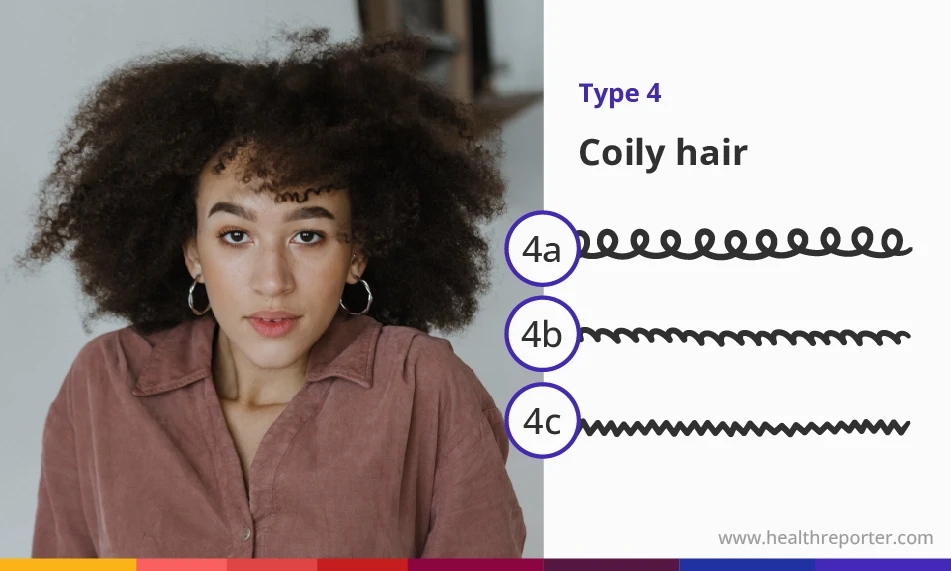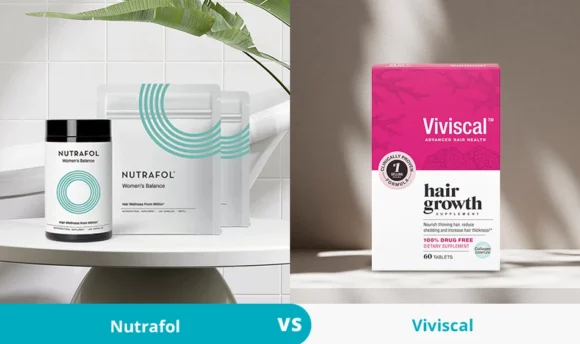Type 4 Hair: How to Keep Your Coils Healthy and Embrace Them
If you have coily (type 4) hair, you need to care for it in a certain way to maintain healthy and shapely coils. Read this guide to coily hair and learn to embrace your natural curl pattern at home with some essential tips.

Of the 4 hair types, type 4 is one of the most demanding. Many women with this hair type deal with common woes, such as dryness, shrinkage, and unruliness. It requires a different haircare system than straight and wavy hair types.
While it can be challenging to manage, having the proper routine in place will make your hair journey much more manageable. With a few good habits, you will soon take pride in owning your beautiful kinky hair.
Are you ready to make the most of your natural hair? Uncover how to highlight your curl pattern for luxurious curls every day.
What Is Type 4 Hair?
Type 4 hair is coily or kinky hair. It is identified by a densely packed mass of tight coils that appear full of energy and volume. These curls range from crochet needle-sized coils with a visible S pattern to kinky strands with a zigzag pattern that travels from root to tip.
The tightly coiled strands have a spongy hair texture that is either super fine and soft or coarse and wiry, depending on genetics. It’s prone to breakage and dryness because the curl pattern makes it difficult for the scalp to evenly distribute natural oils (sebum) throughout.

There are 3 subcategories for this hair type: 4a, 4b, and 4c.
#1 Type 4a hair
Type 4a hair is characterized by large, tight coils about the width of a crochet needle. When loose (stretched), they form an S-shaped pattern and shrink slightly when going from wet to dry. It retains moisture better than 4b and 4c types but still struggles with dehydration.
#2 Type 4b hair
Type 4b hair can be recognized by its unique zigzag pattern. The strands are more tightly packed than type 4a hair, and the texture varies from fine to coarse. It has a fluffy appearance and tends to be very dry. Again, moisture is a problem for type 4b hair because the hair bends at sharp angles.
#3 Type 4c hair
Type 4c hair has the tightest curls of all curly hair types. These tight corkscrews are coarse and very tightly packed. People with this hair type tend to experience significant shrinkage, which creates extreme volume. However, these strands are fragile and prone to breakage and frizz.
Type 4 Hair Comparison Table
You can use a special hair typing system to understand your curl type. Understanding your natural hair type can help you implement the best routine for gorgeous-looking curls. The chart compares the texture, curl pattern, and oiliness of hair types in the number 4 category.
| Grade | Texture | Curl pattern | Oiliness |
| 4A | Spongy hair texture Softer and finer than 4b and 4c | Large tight coils with the circumference of a pencil or crochet needle The coils form an S-shape | Rarely becomes oily as the curls begin at the roots |
| 4B | Varies between being fine and thin or coarse and wiry | Tightly packed coils The coils are Z-shaped or form a zigzag pattern | Doesn’t usually become oily, but product buildup is possible |
| 4C | Coarser texture | Tight corkscrew curls, very densely packed | Naturally dry, but may become oily at the scalp due to product buildup Most prone to dry ends as the sebum struggles to travel down the hair shaft |
How to Take Care of Type 4 Hair: From Washing to Styling
You can build a solid haircare routine at home that promotes long-term hair health. Hair products, intense moisturizing, and limiting wash days are essential practices for all curl types.
Here are some ways to care for your coily hair.
#1 Choose a moisturizing shampoo
Moisturizing products are always best for those in the curly community. Starting your routine with a moisturizing shampoo will ensure long-lasting hydration. Those containing natural oils, such as argan oil, avocado oil, and coconut oil, are great for rehydrating dry coily tresses.
Stay away from shampoos with sulfates and parabens. These ingredients strip away the hair’s natural sebum levels, worsening already dry strands.
Another popular trick for dry, mixed-textured, and ultra-curly hair is to use a co-wash regimen. That means skipping the shampoo wash and cleansing with conditioner only to help maintain moisture levels. Just be sure to rinse thoroughly to prevent product buildup.
#2 Detangle with care
Coily hair is no stranger to tangles and knots, but you should never attack the strands with a brush or try to detangle them when the hair is dry. Instead, use a wide-tooth comb on wet hair and work slowly and carefully through the tangles.
Some people prefer to detangle this hair type by using their fingers as a comb-like tool. This is a great way to minimize damage to your curls during the detangling process. Coating the strands with conditioner and working in sections can make the process easier and less painful.
#3 Dry your hair the right way
Limiting heat and friction is the best route for the coily hair type. Blotting your hair dry with a microfiber towel or soft cotton t-shirt is the best way to dry hair for minimal damage. It can help prevent frizz, too, as long as you don’t rub the hair and ruffle the cuticle layer.
In those times when you need to dry your hair quickly, use a blow dryer on the lowest possible heat setting after applying a moisturizing heat protectant spray.
#4 Condition generously
Type 4 hair craves moisture, so following up your hydrating shampoo with a good quality conditioner every time you wash is vital. You can then continue to hydrate your dry hair with a leave-in conditioner and hair oil to solidify your conditioning routine.
Using a deep conditioner on occasion has multiple perks for coils. Deep conditioning is the act of using a special conditioning treatment containing higher concentrations of ingredients. It helps reinforce moisture levels and adds softness and shine.
Curls, coils, and those with a rough hair texture can benefit from ingredients like shea butter and various carrier oils to replenish moisture.
#5 Don’t forget about your hair at night
A poor sleep routine with any form of curly hair can leave your mane frizzy, matted, and with less definition. You can use protective styles to keep your curls safe and happy while you sleep. One of the most popular examples of a protective style is “the pineapple.”
The pineapple style is when you tie your hair up at the top of your head using a soft hair scrunchie tied loosely. You can then cover your head with a silk scarf for extra protection.
Covering your pillow with a satin or silk pillowcase will also help to eliminate friction and keep the hair neat as you move your head during the night.
Type 4 Hair Styling Ideas
There are so many ways to style your type 4a, 4b, or 4c hair. You can add layers to boost the definition, movement, and bounciness of your coils while keeping knotting to a minimum. Short hairstyles, like the pixie cut, are great for creating a stylish look full of texture.
You can even have fun with braids, Bantu knots, and beautiful voluminous afros.
Just remember that frequently fashioning your hair with tight styles that pull on the hair roots can cause scalp tension, breakage, hair shedding, and hair loss. This type of hair loss is called traction alopecia and is common among women with tightly spiraled hair.
FAQs
Type 4 is one of the most common hair types among people of African descent. It is present but less common among other races.
You can grow your type 4 hair long with the proper haircare routine. However, this hair type comprises tight curls that experience more shrinkage when going from wet to dry, making it look shorter than it is.
You should avoid brushing your type 4 tresses because it pulls at the vulnerable hair strands, causing damage and split ends. If you want to brush your hair, it’s best to comb it while wet with conditioner in the shower to avoid breakage.
A Word From a Trichologist
People with type 4 hair have tight curls that form the shape of the letter S or Z when pulled straight. It comprises dense strands that are resistant to losing their shape, even when wet. While it looks tough, coily hair has the fewest cuticle layers to keep it safe from breakage.
You can protect these vulnerable curls with ultra-hydrating products, a regular conditioning schedule, and natural styling methods that avoid heat. The length and ends can dry out, but you should still cleanse your scalp often enough to keep your follicles free from buildup.
Regular trims are another crucial part of hair maintenance for type 4 hair. Removing the split ends will reduce further breakage and over-tangling while supporting healthy hair growth.
Conclusion
Type 4 hair has tighter curls than wavy and curly hair types. It comes in a variety of textures and is mostly very dry. It is the most fragile of the natural hair types, making it more prone to breakage, tangling, and frizz.
That’s why you need to give this hair type extra care with plenty of moisture, gentle detangling, and protection while you sleep. Use the hair typing system to pinpoint your exact curl type for the best care.

















































 Select your language:
Select your language: 








